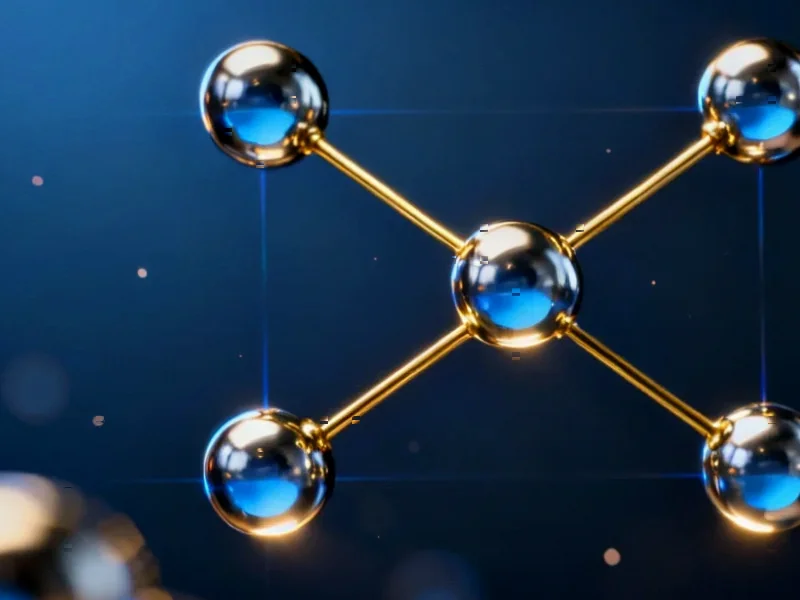According to SciTechDaily, researchers from WPI-ICReDD at Hokkaido University have developed a computational method that accurately predicts optimal ligands for photochemical palladium catalysts, enabling new radical reactions with alkyl ketones. Published on October 20, 2025 in the Journal of the American Chemical Society, the team used their Virtual Ligand-Assisted Screening (VLAS) method to analyze 38 different phosphine ligands and identified tris(4-methoxyphenyl)phosphine as the optimal choice that successfully suppresses back electron transfer – a problem that has plagued alkyl ketone reactions for decades. The breakthrough allows chemists to generate ketyl radicals from common alkyl ketones, which are much more prevalent than aryl ketones but have remained difficult to manipulate due to their chemical structure. This computational approach represents a significant shift in how chemical reactions can be developed and optimized.
The Computational Revolution in Chemical Discovery
This breakthrough represents more than just solving one specific chemical challenge – it signals a fundamental shift in how organic chemistry research will be conducted in the coming decade. The traditional approach of trial-and-error experimentation, while effective, has always been limited by human capacity and laboratory resources. What makes the VLAS method particularly revolutionary is its ability to screen thousands of potential ligands computationally before ever touching a test tube. This isn’t just about speed; it’s about exploring chemical spaces that would be practically inaccessible through conventional methods. The published research demonstrates how computational chemistry is evolving from a supporting tool to the primary driver of discovery.
Transforming Pharmaceutical Development Timelines
The ability to reliably generate alkyl ketyl radicals opens entirely new synthetic pathways that pharmaceutical companies have been seeking for years. Alkyl ketones are ubiquitous in organic molecules, particularly in complex natural products and drug candidates. Previously, chemists had to design around these challenging substrates or use less efficient methods. With this breakthrough, we can expect to see accelerated development of new drug candidates, particularly in areas like complex natural product synthesis and targeted molecular libraries. The implications extend beyond just new reactions – this could shorten drug discovery timelines by months or even years for certain compound classes, representing billions in potential cost savings across the industry.
The Green Chemistry Dividend
One of the most underappreciated aspects of this computational approach is its environmental impact. Traditional ligand screening generates substantial chemical waste and consumes significant resources. By computationally predicting the optimal ligand from thousands of possibilities and testing only the most promising candidates, researchers dramatically reduce their environmental footprint. This aligns with the growing movement toward green chemistry principles in academic and industrial research. As computational methods become more sophisticated, we’ll see even greater reductions in chemical waste while accelerating discovery – a rare win-win scenario in chemical research.
Where This Technology Is Headed
Looking ahead 12-24 months, I predict we’ll see rapid adoption of similar computational screening methods across multiple areas of catalysis. The success of VLAS with palladium catalysts suggests the approach could be generalized to other metal catalysts and reaction types. Pharmaceutical and specialty chemical companies will likely invest heavily in developing their own computational screening capabilities or partnering with academic groups specializing in these methods. We may also see the emergence of specialized software platforms that make these computational tools more accessible to synthetic chemists without deep computational backgrounds. The research community is clearly moving toward integrated computational-experimental workflows as the new standard for chemical discovery.
Broader Implications for Chemical Education and Training
This breakthrough highlights a growing skills gap in chemical education. Traditional chemistry programs still emphasize manual synthetic techniques with limited computational training. The success of approaches like VLAS suggests that future chemists will need to be equally comfortable with coding and computational modeling as they are with round-bottom flasks and chromatography. Academic institutions will need to rapidly adapt their curricula to produce chemists who can operate at this computational-experimental interface. The researchers who made this discovery represent the new model of chemical researcher – equally skilled in organic synthesis and computational methods, able to move seamlessly between virtual screening and laboratory validation.
Commercialization and Scaling Challenges
While the academic breakthrough is impressive, the real test will come in scaling these reactions for industrial applications. Photochemical reactions often face challenges in scaling due to light penetration issues in larger reaction vessels. Additionally, the specialized ligands identified through computational screening may be expensive or difficult to produce at scale. However, the computational approach itself provides a pathway to address these challenges – researchers can now screen for ligands that are not only effective but also commercially viable and scalable. The next phase of this research will likely focus on optimizing these reactions for practical industrial applications, potentially transforming how fine chemicals and pharmaceutical intermediates are manufactured.




